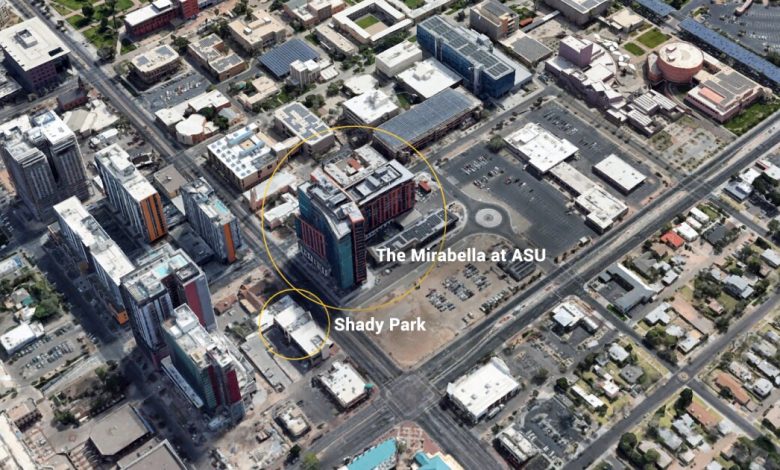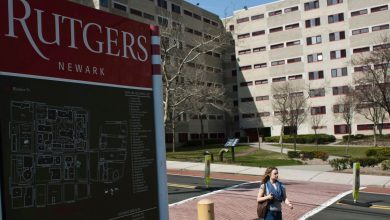At Arizona State, a Town-Gown Squabble With a Twist

Inside an Arizona State University apartment building on a recent Friday afternoon, the sounds of piano, bassoon, and guitar filled an event room, where four graduate-student musicians played songs with their neighbors, all of whom were in their 60s or older.
The residents of the university-affiliated senior-living community grabbed instruments, sang along, clapped, and delivered standing ovations.
These jam sessions at the new 20-story retirement complex, called Mirabella at ASU, have provided the soundtrack for dinners and events. They’ve helped older residents revive long-forgotten musical hobbies. And they’ve helped build intergenerational relationships.
“These residents are so kind and they’re so wise. Being able to live with them and learn from them has been, I think, the biggest advantage,” said Michelle Kim, a 31-year-old doctor of musical arts candidate who lives at the Mirabella as one of four student “musicians in residence.”
Outside the Mirabella, though, music has become a problem — specifically, the heavy, late-night bass from Shady Park, a venue across the street known for playing live electronic-dance music. Until recently.
The retirement community sits right on ASU’s Tempe campus, in a neighborhood packed with bars, restaurants, and clubs. The university broke ground for the building in 2018, joining a wave of new construction, with high-rise hotels with rooftop bars and apartments lining a part of downtown that had been a bit sleepier.
When residents started moving into the Mirabella at the very end of 2020, the pandemic had shuttered Shady Park. But by mid-2021, the venue was back in full swing. And the complaints from Mirabella residents — and also from nearby hotels and apartments — began soon after: The vibrating bass was disturbing their peace. Mirabella at ASU, a nonprofit corporation an ASU-affiliated group set up in partnership with Pacific Retirement Services, decided to sue.
The vibrations were “so intense that they cause one resident’s electric bed to turn on automatically and begin adjusting in the middle of the night,” the court complaint said.
“I am a native New Yorker and lived and worked in Manhattan for several years, on a block with a pub on the corner and a fire station down the street, and I never had to deal with this level of disruption to my work and sleep,” Edward Kavazanjian, a Mirabella resident and ASU professor of geotechnical engineering, said in a statement to the media.

Rebecca Noble for The Chronicle
The judge sided with the residents in April, telling Shady Park to turn it down and slicing the venue’s live music hours to the point that it stopped hosting the outdoor shows it is known for. Shady Park appealed the ruling this month.
“It’s not that [the residents] don’t belong there. Of course they belong there. Tempe is a town of inclusion,” said Scott Zwillinger, an attorney for Shady Park. “The idea of having older people and their life experience on a college campus, all of those make sense and seem like good values. But that doesn’t mean they can just show up and change the area.”
A Change.org petition signed by nearly 30,000 supporters of Shady Park pointed out that it was there first, opening in 2015. A protest after the court ruling even revolved around music: People gathered outside the complex, banging on drums and screaming up at the Mirabella tower, carrying signs that said, “If you don’t like it here, LEAVE,” and, “Just buy earplugs.”
It’s a town-gown conflict with a twist: Rowdy students from campus aren’t disturbing townies; instead, established businesses in town are disturbing the “lifelong learners” ASU has invited onto campus.
The central question among observers has been: Why are retirees on a college campus in the first place? And why, specifically, adjacent to the main entertainment district?
“They could’ve put their retirement community anywhere else, and they put it in the middle of downtown Tempe. That seems like poor planning to me because it’s literally in the entertainment district,” said Haley Tenore, a senior journalism student who wrote an op-ed about the conflict.
A Growing Market
Colleges across the country that are putting up similar “university-based retirement communities” may want to take note of what’s happening in Tempe.
“The Shady Park conflict has kind of bubbled up to the surface these kinds of existential questions of who belongs here,” said Lindsey Beagley, the director of lifelong university engagement for ASU Enterprise Partners.
While exact data is hard to find given the different natures of the affiliations with campuses and retirement communities, several experts in the sector said university-based retirement communities are clearly on the rise.
At a time when enrollment goals can be hard to meet, the projects offer revenue. They often use college-owned land that would otherwise be dormant and trade on the institution’s name to attract a new class of retiree: someone who wants a more active life, who wants to keep learning, and who wants to stay young by being near other generations.
“If you look at demographics and enrollments going down, you’ve really only got two choices: You can hope we all start giving birth to babies who start college at age 5, or you can recycle some of your old customers. So which one’s easier?” said Andrew Carle, a consultant who specializes in university-based senior-housing projects.
Most such projects are near a campus, not on one like the Mirabella. There, a dedicated office helps residents who want to audit classes free of charge or attend campus events. The connection between the campus and the community was designed to be direct and constant.

Rebecca Noble for The Chronicle
Either way, colleges should consider the different life stages of their typical student and a retiree, said Robert G. Kramer, a co-founder of the National Investment Center for Seniors Housing & Care. Most older people go to bed earlier and wake up earlier than a college student in their late teens or early 20s.
“You have two very conflicting lifestyles from the hours of probably 9 o’clock at night until 4 in the morning,” Kramer said. As a result, “you’re setting up generational conflict, where part of the whole idea is to have the value of multiple-generation interaction,” he said. The conflict in Tempe “sounds like an unfortunate situation, but one that could have easily been predicted.”
When planning the Mirabella, ASU considered a spot farther away from the entertainment district, which would’ve been quieter, but the locale’s buzzy nature was part of the appeal, Beagley said. The farther away the community, the less likely it would be to actually connect with students and the campus, she said.
The building was designed with soundproofing in mind, said Thomas Dorough, the executive director of the Mirabella. There are flight paths above and car traffic on the ground.
And for residents, the location made the Mirabella stand out.
“I would never go to a place where you got to sit around and play golf all day,” said Emily Zeigler, a 74-year-old who came to Tempe from New York City and plays the flute at the evening sessions.
A Lucrative Project
The Mirabella doesn’t come cheap. Residents pay an entrance fee of about $450,000 up to $2 million, about 80 percent to 90 percent of which is refundable to the residents’ estate. They also pay a monthly fee of about $4,500 to $5,000 to cover dining, utilities, programming, and housekeeping. Still, the Mirabella initially sold out. But now, its occupancy rate sits at about 60 percent — a decline its operators attribute to the toll of the pandemic.
It has been a lucrative project for ASU. The university got $7 million up front from the Mirabella’s operators for a long-term ground lease. ASU will also get additional payments based on what property taxes would have been for the land if it weren’t exempted because it’s owned by the university, a controversial arrangement called “payment in lieu of taxes.”
Beyond the immediate revenue stream, colleges can tap into their retirement-community residents as potential donors, who may even be inclined to leave parts of their estate to a college, Kramer said.
Carle set up five criteria for a successful UBRC: proximity to campus (ideally one mile or less away), programming that integrates the residents with the college, a continuum of care levels for seniors (like skilled nursing and memory care), a financial relationship between the university and the senior-housing provider, and at least 10 percent of residents who were affiliated with the university (like alumni or faculty).
The Mirabella, he noted,meets all five. He contrasted it with other college-owned retirement communities that are many miles off campus, effectively cutting their residents off from the benefits of being on or near a college campus.
“I’ve seen this in more than one university, where they just plop it out on a piece of land that they had and couldn’t figure out what to do with it. That’s not a reason to build somewhere in my business,” Carle said.
The conflict put Tempe in the crosshairs. The city councilsided with Shady Park, saying the court ruling would keep Tempe from enforcing its own codes, like noise ordinances. (Shady Park had not been cited for any city noise-ordinance violations, despite complaints from residents. Court documents note that the city rarely issues citations to enforce its noise ordinance.)
Tempe helped review the proposal for the complex but ultimately had no say, Vice Mayor Randy Keating pointed out. The Mirabella is on ASU property.
Still, Keating insists, the Shady Park-Mirabella conflict doesn’t affect the city’s relationship with its biggest employer. Tempe and ASU still rely on each other’s success.
“The Mill Avenue area in particular has gone from a very college-oriented scene to a little bit more, quote-unquote, grown up,” Keating said. “I think anyone that wants to live in Tempe or in our downtown urban core should be able to do so. But you need to understand where you’re going, what’s there, and essentially everyone work to be good neighbors together.”
‘My Calendar Is Full’
Inside the Mirabella, it’s easy to see the benefits of different generations living together. The four students who live with the 230-some retirees clearly built strong ties in just one year. The retirees say they’re invigorated by being at a college again.
Eric and Sue Brash, who moved from Fountain Hills, a sleepier part of the Phoenix metro area, say they felt brought to life by the Mirabella. Eric, in particular, felt lonely in Fountain Hills. He didn’t know his neighbors.
“I was almost despondent out there. And being here, I don’t have time for that sort of stuff. We’re too busy. My calendar is full,” he said.
The students have also benefited: They receive room and board in exchange for two music-related events per week, which they thought would mostly be performances at dinner. Instead, they’ve taught lessons to residents, practiced for their coursework, and formed friendships.

Rebecca Noble for The Chronicle
“What I personally gained more and value more is being able to live here and kind of breaking that age gap between the older generation and the younger generation,” said Kim, the doctoral music student.
On a recent Saturday evening, residents’ apartments were still lit up after 10 p.m. as nearby bars served drinks and a DJ played on one hotel’s rooftop. People headed to Shady Park to get food, with no live music.
All sides want to see some kind of resolution, perhaps outside the courts, so that Shady Park can continue to play music and Mirabella residents can live peacefully in their new community. Exactly how that will happen isn’t clear. Shady Park had already put up a sound canopy to try to dampen the noise before the Mirabella filed suit. Maybe it needs another, or maybe more sound barriers need to be installed at the retirement community.
Mirabella at ASU representatives and residents emphasize that they don’t want Shady Park to shut down. “No one’s ever said we don’t want them to play music. No one’s ever said we want them to go out of business or anything,” said Dorough, the executive director. “That’s not our intent. We just wanted them to turn it down, be reasonable, so the residents here can enjoy their apartments.”
Source link






